and you move my mind from behind the wheel when I lose control
Wandering, of a morning, gathering Twitter links, perusing them, sending out blog entries into the wilds. Coffee, keys, dawning understanding. This is my average morning, slow and oddly-paced, but I'm comfortable within its structure.
Then I came across Sapphire Weatherwax's blog. And her mention of the Virtual Hallucinations project.
"The Project warns that it is not a good idea to go through it if you’ve experienced psychosis, however, and I wouldn’t recommend it to anyone who’s currently very depressed or battling intrusive negative thoughts of any kind", she says, and I have no doubt she means it. But me being me, I had to know.
UC Davis put this together, and when I arrived on site, I was standing on a hillside outside the building proper. I had to wait some time for everything to rez in, but I'm fairly sure that was either a) my system, or b) Second Life's special new inflated-lag system. Or both.
Once everything seemed to be rezzed in, I went in for a look.
There are two yellow pillars by the entrance. One gives you a notecard about the experience:
The virtual hallucinations project seeks to educate people about the mental illness schizophrenia. About 1% of the population will develop schizophrenia during their lifetimes. It usually strikes in the late teens or early twenties, and is very debilitating.
People with schizophrenia have "disordered thought" or difficulty maintaining thought processes. They develop delusions, like the belief that the police are after them. They also experience auditory hallucinations, typically one or more voices speaking to or about them. About 25% of people with schizophrenia also experience visual hallucinations, typically distortions of the environment around them.
This clinic building is based on the hallucinations of two specific people with schizophrenia. They were interviewed in detail and gave feedback on early designs for the hallucinations. While the hallucinations are not glamorous, they fairly accurately reproduce these patients' experiences. You should get a sense of just how intrusive the voices of schizophrenia really are.
Fine, so far.
The virtual hallucinations environment is best experienced in mouselook. One person should go through at a time.
I loathe mouselook. So don't take my experience as the best; I didn't want to deal with the mouselook limitations, so I didn't go in in mouselook, that simple.
Another lass happened by the project while I was reading the first notecard, so I let her go through while I looked at the second:
Some people find the virtual hallucinations experience disturbing, particularly the voices. If you find it bothersome, just walk to the end of the clinic and click the "Stop Voices" button.
If you have a history of mental illness, particularly a psychotic disorder, you should not tour this facility.
The virtual hallucinations environment has been experienced without difficulty by a few people with well-controlled schizophrenia. They found it interesting and educational. However, I don't know if experiencing a version of someone else's hallucinations is helpful or harmful. While I doubt it could induce hallucinations, I don't know for sure.
So please be careful. Remember that you can quit at any time.
Yeah, so...this is not exactly a well-kept secret on the grid? But I'm not precisely stable. I have two consistent, and one intermittent, hallucinations. None of them tell me to hurt other people, and none of them tell me to hurt myself. But it's indicative of damage.
I accept this; while it has worried certain psychiatrists in the past, I know what I'm seeing and hearing is not real, and apart from gaining the one occasional this year, I've had the basic two for eight to ten years with nothing further impacting my life. I figured, though, I might be just the type of person who might not be completely okay with this, so I told Fawkes that I was going through.
[17:36] Fawkes Allen: This does not sound like a terribly smart idea honestly. And I do wonder how that is supposed to work.
[17:36] Emilly Orr: Yeah....it's likely not. And they give you a HUD with voices, I know that much, and there are also visual distortions, I believe.
Huh. Why was I worried?
Figuring I was already on a roll, though, I went over to the gallery the Survivors of Suicide website has set up. I was initially mildly freaked out, because the official prim greeter was headless. Then his head rezzed in, and I relaxed. It was just a prim issue.
The SLUrl drops you off in the ampitheatre, which is actually above the gallery. But it's a quick walk down, which gives things time to rez in. There's a sign on the gallery door:
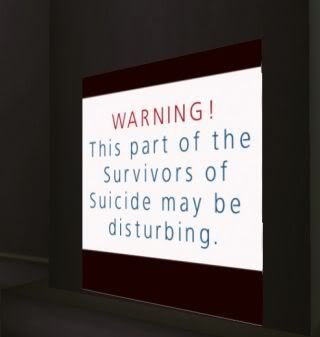
Warning! This part of the Survivors of Suicide may be disturbing.
In this case? They're not kidding.
[18:22] Alone: A person dies by suicide about every 16 minutes in the United States. An attempt is estimated to be made once every minute.
It's not an easy gallery to walk through. Blood, images of blood, a whole bathtub of blood--the theme is prevalent.
[18:22] Curling up inside: Over 60 percent of all people who die by suicide suffer from major depression. If one includes alcoholics who are depressed, this figure rises to over 75 percent.
Just about everything can be touched for more information. Some objects spit out green info text; some hand you notecards.
[18:23] head-depression: If you think someone is suicidal, do not leave him or her alone. Try to get the person to seek immediate help from his or her doctor or the nearest hospital emergency room, or call 911. Eliminate access to firearms or other potential tools for suicide, including unsupervised access to medications.
Being watched? Annoying as hell. Living through being watched? Infinitely better.
[18:23] Moving Picture: If you're unsure whether someone is suicidal, the best way to find out is to ask. You can't make a person suicidal by showing that you care. In fact, giving the individual the opportunity to express his or her feelings may prevent a suicide attempt. The person may even be relieved that you brought up the issue.
They're right, here. If someone is already suicidal, asking them won't change their mind. If someone is not, asking them won't make them suddenly leap up, grin like a maniac, and dash off for the knives.
In other words, you cannot influence their mental state negatively just by asking. So for the love of all gods, if you're worried--ask.
[18:24] eyeball : If you spot the warning signs of suicide in someone you care about, you may wonder if it’s a good idea to say anything. What if you’re wrong? What if the person gets angry? Even worse, what if you plant the idea in your friend or family member’s head? In such situations, it's natural to feel uncomfortable or afraid. But anyone who talks about suicide or shows other warning signs needs immediate help—the sooner the better.
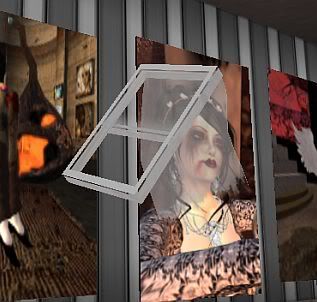
Some of the objects didn't seem to make a lot of sense--the potted plant that handed out suicide and depression tips, for instance. But the curtains flowing in the wind from the floating windows--oh, yeah, those I got. The bathtub full of blood--which, oddly, is not scripted to hand out anything--and the pictures, yeah, I got those too.
[18:24] Sharp objects: People with AIDS have a suicide risk up to 20 times that of the general population.
This? Does not surprise me in the least.
[18:25] Casket: There are an estimated 8 to 25 attempted suicides to 1 completion.
This, weirdly, did.
[18:26] Headstone: •Almost four times as many males as females die by suicide; but, women report attempting suicide during their lifetime about three times as often as men.
And this. "Successful" suicides are higher among men than women. Okay, fine. (Well, not fine, but okay, I get that, I understand that.) But suicide attempts are higher among women? Not suicide completions. Just attempts.
One wonders why, really. They're found easier? Their behavior when suicidally depressed is more obvious? They don't really want to die, just to end the unendurable pain? What is it?
[18:27] Fern: About 15 percent of the population will suffer from clinical depression at some time during their lifetime. Thirty percent of all clinically depressed patients attempt suicide; half of them ultimately die by suicide.
This, also, was a statistic that held no surprise for me.
To 'get out' of the main gallery, you touch the mirror. For me, my avatar then disappeared, and I had to cam to find out where I'd gone. Turned out I'd gone...

here.
The colors were brighter, and there was an entire wall of resources, but...beyond that, to be honest, the other side was more interesting. Still, I lit a remembrance candle, made a donation, and went back home to think.
A potentially coming Twilight MMO? Shoot me now. Nineteen times. Gah.
And I tracked down the code of ethics for professional journalists. (Mind, I don't consider myself a professional journalist; first, I'm not paid for it, and second, if I'm anything, I'm a muckraker.)
Gary Arther Douglas II takes on freebies on the grid--and weirdly, not in a way I approve. I am all for freebies, dollarbies, and cheapies, because let's face it, the SL economy still sucks. But this fellow seems to be encouraging two things I'm profoundly against:
1. Listing on XStreet; and
2. Releasing everything for free.
No. Just no. Possibly even, never.
All in all, though, I won't lie that there are unsettling spots for me in both places--things that move on their own have always unnerved me, and I know why, but the laptops clapping shut and open made me twitch. And then walking around a gallery where all the art featured the dead or the dying, while everything 'spoke' to me on suicide statistics...not exactly comforting.
Still, the worst part of the two hours I just spent on SL? Waiting for things to rez in. And having to relog twice to clear enough cache so I could finally load in enough of my inventory to change out of Christmas hair. Proving once and for all, the biggest, most disturbing thing on SL? Is SL itself.
Then I came across Sapphire Weatherwax's blog. And her mention of the Virtual Hallucinations project.
"The Project warns that it is not a good idea to go through it if you’ve experienced psychosis, however, and I wouldn’t recommend it to anyone who’s currently very depressed or battling intrusive negative thoughts of any kind", she says, and I have no doubt she means it. But me being me, I had to know.
UC Davis put this together, and when I arrived on site, I was standing on a hillside outside the building proper. I had to wait some time for everything to rez in, but I'm fairly sure that was either a) my system, or b) Second Life's special new inflated-lag system. Or both.
Once everything seemed to be rezzed in, I went in for a look.
There are two yellow pillars by the entrance. One gives you a notecard about the experience:
The virtual hallucinations project seeks to educate people about the mental illness schizophrenia. About 1% of the population will develop schizophrenia during their lifetimes. It usually strikes in the late teens or early twenties, and is very debilitating.
People with schizophrenia have "disordered thought" or difficulty maintaining thought processes. They develop delusions, like the belief that the police are after them. They also experience auditory hallucinations, typically one or more voices speaking to or about them. About 25% of people with schizophrenia also experience visual hallucinations, typically distortions of the environment around them.
This clinic building is based on the hallucinations of two specific people with schizophrenia. They were interviewed in detail and gave feedback on early designs for the hallucinations. While the hallucinations are not glamorous, they fairly accurately reproduce these patients' experiences. You should get a sense of just how intrusive the voices of schizophrenia really are.
Fine, so far.
The virtual hallucinations environment is best experienced in mouselook. One person should go through at a time.
I loathe mouselook. So don't take my experience as the best; I didn't want to deal with the mouselook limitations, so I didn't go in in mouselook, that simple.
Another lass happened by the project while I was reading the first notecard, so I let her go through while I looked at the second:
Some people find the virtual hallucinations experience disturbing, particularly the voices. If you find it bothersome, just walk to the end of the clinic and click the "Stop Voices" button.
If you have a history of mental illness, particularly a psychotic disorder, you should not tour this facility.
The virtual hallucinations environment has been experienced without difficulty by a few people with well-controlled schizophrenia. They found it interesting and educational. However, I don't know if experiencing a version of someone else's hallucinations is helpful or harmful. While I doubt it could induce hallucinations, I don't know for sure.
So please be careful. Remember that you can quit at any time.
Yeah, so...this is not exactly a well-kept secret on the grid? But I'm not precisely stable. I have two consistent, and one intermittent, hallucinations. None of them tell me to hurt other people, and none of them tell me to hurt myself. But it's indicative of damage.
I accept this; while it has worried certain psychiatrists in the past, I know what I'm seeing and hearing is not real, and apart from gaining the one occasional this year, I've had the basic two for eight to ten years with nothing further impacting my life. I figured, though, I might be just the type of person who might not be completely okay with this, so I told Fawkes that I was going through.
[17:36] Fawkes Allen: This does not sound like a terribly smart idea honestly. And I do wonder how that is supposed to work.
[17:36] Emilly Orr: Yeah....it's likely not. And they give you a HUD with voices, I know that much, and there are also visual distortions, I believe.
[17:37] Emilly Orr: HUD-based, maybe?
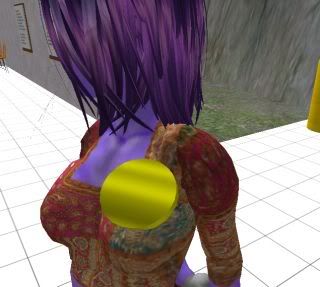
It is, actually, in the form of a VERY large, intrusive yellow circle I'm told to wear. It cannot be modified; I get why, in terms of what they want it to do, but...man, that sucker's HUGE.
Someone else came in while I fiddled with the badge, and, sighing, I waited until she was at least out of my view, before walking on. I don't mind that the project has visitors; I'd rather it did, most people just don't understand mental illness as a whole. But being instructed to go through it alone...when people are constantly porting in....yeah. That was difficult.

The soundtrack isn't that upsetting to me personally; I've done combat with my personal set of 'voices' (my favorite trick to date: any severe teardown thoughts you have? Give them Disney voices. It's really, really hard to take seriously Donald Duck telling you you're worthless). But walking into the reception area got me: I took a picture, but what you don't see in it is what's so odd: all the laptops were moving, almost 'clapping', discordantly. Always.
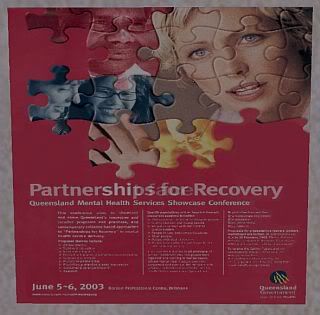
I was a bit confused by the instructions to look at the "red poster" to see an example of schizophrenic visual distortions. Am I missing something? The printing was blurred, and there was at least one puzzle section on fire, but--considering some ads and videos* I've seen? That's nothing.
(*Just FYI--I was thinking of linking Aphex Twin for the video, but the Dir en Grey is worse. I have a hard time watching "Obscure", and I like other Dir en Grey songs. That one--visuals to sound--gets under my skin and lays eggs. It is profoundly disturbing.)
What made this odd for me, personally, were the SL conventions in the midst of everything--look out a window, see deep ocean in one direction; look out the window and see a Japanese temple on an island, in the other. I don't think these were intended to add to the experience, but they did.
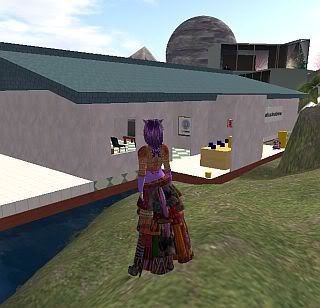
Miss Weatherwax reported extreme disturbance, to the point of tears. It may or may not unsettle my readers to find that the things that most disturbed me? Were the things they didn't cover.
Like walls that breathe. Or bleed. Like radio static that never stops, that one can't turn off, because it appears to be coming from potted plants, or the milk in the fridge, or fingernails. Like scratching at insects burrowing under the skin until the skin bleeds. Like being convinced that something has been implanted under the skin, to the extend of 'digging it out' with a scalpel one afternoon.
And--apart from the walls breathing, because that's one of mine--I'm not talking about me. I'm talking about people I've known personally. The random screaming. The speaking in tongues. The sharp twitching whenever people they don't know approach them from behind. The fact that sometimes, I'd have to disarm people before I introduced them to others, and still knew they had at least two weapons I hadn't found, so just hoped for the best.
And that, for the most part, all of us--these friends and I combined--think schizophrenics are worse.
This? This was mild. This was a cakewalk compared to walking around a lockdown ward. This was...nothing.

It is, actually, in the form of a VERY large, intrusive yellow circle I'm told to wear. It cannot be modified; I get why, in terms of what they want it to do, but...man, that sucker's HUGE.
Someone else came in while I fiddled with the badge, and, sighing, I waited until she was at least out of my view, before walking on. I don't mind that the project has visitors; I'd rather it did, most people just don't understand mental illness as a whole. But being instructed to go through it alone...when people are constantly porting in....yeah. That was difficult.

The soundtrack isn't that upsetting to me personally; I've done combat with my personal set of 'voices' (my favorite trick to date: any severe teardown thoughts you have? Give them Disney voices. It's really, really hard to take seriously Donald Duck telling you you're worthless). But walking into the reception area got me: I took a picture, but what you don't see in it is what's so odd: all the laptops were moving, almost 'clapping', discordantly. Always.

I was a bit confused by the instructions to look at the "red poster" to see an example of schizophrenic visual distortions. Am I missing something? The printing was blurred, and there was at least one puzzle section on fire, but--considering some ads and videos* I've seen? That's nothing.
(*Just FYI--I was thinking of linking Aphex Twin for the video, but the Dir en Grey is worse. I have a hard time watching "Obscure", and I like other Dir en Grey songs. That one--visuals to sound--gets under my skin and lays eggs. It is profoundly disturbing.)
What made this odd for me, personally, were the SL conventions in the midst of everything--look out a window, see deep ocean in one direction; look out the window and see a Japanese temple on an island, in the other. I don't think these were intended to add to the experience, but they did.

Miss Weatherwax reported extreme disturbance, to the point of tears. It may or may not unsettle my readers to find that the things that most disturbed me? Were the things they didn't cover.
Like walls that breathe. Or bleed. Like radio static that never stops, that one can't turn off, because it appears to be coming from potted plants, or the milk in the fridge, or fingernails. Like scratching at insects burrowing under the skin until the skin bleeds. Like being convinced that something has been implanted under the skin, to the extend of 'digging it out' with a scalpel one afternoon.
And--apart from the walls breathing, because that's one of mine--I'm not talking about me. I'm talking about people I've known personally. The random screaming. The speaking in tongues. The sharp twitching whenever people they don't know approach them from behind. The fact that sometimes, I'd have to disarm people before I introduced them to others, and still knew they had at least two weapons I hadn't found, so just hoped for the best.
And that, for the most part, all of us--these friends and I combined--think schizophrenics are worse.
This? This was mild. This was a cakewalk compared to walking around a lockdown ward. This was...nothing.
Huh. Why was I worried?
Figuring I was already on a roll, though, I went over to the gallery the Survivors of Suicide website has set up. I was initially mildly freaked out, because the official prim greeter was headless. Then his head rezzed in, and I relaxed. It was just a prim issue.
The SLUrl drops you off in the ampitheatre, which is actually above the gallery. But it's a quick walk down, which gives things time to rez in. There's a sign on the gallery door:

Warning! This part of the Survivors of Suicide may be disturbing.
In this case? They're not kidding.
[18:22] Alone: A person dies by suicide about every 16 minutes in the United States. An attempt is estimated to be made once every minute.
It's not an easy gallery to walk through. Blood, images of blood, a whole bathtub of blood--the theme is prevalent.
[18:22] Curling up inside: Over 60 percent of all people who die by suicide suffer from major depression. If one includes alcoholics who are depressed, this figure rises to over 75 percent.
Just about everything can be touched for more information. Some objects spit out green info text; some hand you notecards.
[18:23] head-depression: If you think someone is suicidal, do not leave him or her alone. Try to get the person to seek immediate help from his or her doctor or the nearest hospital emergency room, or call 911. Eliminate access to firearms or other potential tools for suicide, including unsupervised access to medications.
Being watched? Annoying as hell. Living through being watched? Infinitely better.
[18:23] Moving Picture: If you're unsure whether someone is suicidal, the best way to find out is to ask. You can't make a person suicidal by showing that you care. In fact, giving the individual the opportunity to express his or her feelings may prevent a suicide attempt. The person may even be relieved that you brought up the issue.
They're right, here. If someone is already suicidal, asking them won't change their mind. If someone is not, asking them won't make them suddenly leap up, grin like a maniac, and dash off for the knives.
In other words, you cannot influence their mental state negatively just by asking. So for the love of all gods, if you're worried--ask.
[18:24] eyeball : If you spot the warning signs of suicide in someone you care about, you may wonder if it’s a good idea to say anything. What if you’re wrong? What if the person gets angry? Even worse, what if you plant the idea in your friend or family member’s head? In such situations, it's natural to feel uncomfortable or afraid. But anyone who talks about suicide or shows other warning signs needs immediate help—the sooner the better.

Some of the objects didn't seem to make a lot of sense--the potted plant that handed out suicide and depression tips, for instance. But the curtains flowing in the wind from the floating windows--oh, yeah, those I got. The bathtub full of blood--which, oddly, is not scripted to hand out anything--and the pictures, yeah, I got those too.
[18:24] Sharp objects: People with AIDS have a suicide risk up to 20 times that of the general population.
This? Does not surprise me in the least.
[18:25] Casket: There are an estimated 8 to 25 attempted suicides to 1 completion.
This, weirdly, did.
[18:26] Headstone: •Almost four times as many males as females die by suicide; but, women report attempting suicide during their lifetime about three times as often as men.
And this. "Successful" suicides are higher among men than women. Okay, fine. (Well, not fine, but okay, I get that, I understand that.) But suicide attempts are higher among women? Not suicide completions. Just attempts.
One wonders why, really. They're found easier? Their behavior when suicidally depressed is more obvious? They don't really want to die, just to end the unendurable pain? What is it?
[18:27] Fern: About 15 percent of the population will suffer from clinical depression at some time during their lifetime. Thirty percent of all clinically depressed patients attempt suicide; half of them ultimately die by suicide.
This, also, was a statistic that held no surprise for me.
To 'get out' of the main gallery, you touch the mirror. For me, my avatar then disappeared, and I had to cam to find out where I'd gone. Turned out I'd gone...

here.
The colors were brighter, and there was an entire wall of resources, but...beyond that, to be honest, the other side was more interesting. Still, I lit a remembrance candle, made a donation, and went back home to think.
A potentially coming Twilight MMO? Shoot me now. Nineteen times. Gah.
And I tracked down the code of ethics for professional journalists. (Mind, I don't consider myself a professional journalist; first, I'm not paid for it, and second, if I'm anything, I'm a muckraker.)
Gary Arther Douglas II takes on freebies on the grid--and weirdly, not in a way I approve. I am all for freebies, dollarbies, and cheapies, because let's face it, the SL economy still sucks. But this fellow seems to be encouraging two things I'm profoundly against:
1. Listing on XStreet; and
2. Releasing everything for free.
No. Just no. Possibly even, never.
All in all, though, I won't lie that there are unsettling spots for me in both places--things that move on their own have always unnerved me, and I know why, but the laptops clapping shut and open made me twitch. And then walking around a gallery where all the art featured the dead or the dying, while everything 'spoke' to me on suicide statistics...not exactly comforting.
Still, the worst part of the two hours I just spent on SL? Waiting for things to rez in. And having to relog twice to clear enough cache so I could finally load in enough of my inventory to change out of Christmas hair. Proving once and for all, the biggest, most disturbing thing on SL? Is SL itself.

Comments
Of med students, men and women have about the same rate of...erm...success. IIRC, the suicide rate of med students might be a little higher than the national average.
If you want, I can dig up the article and link it for you.
Miss Soleil - Interesting statistic. Does that imply male suicides have a better idea of what
will be fatal, or just that the methods men are drawn to tend to be more lethal?
I've also met nurses in psychiatric wards who seemed to have not the least little inkling of what some of their patients went through - the kind who think someone's "being difficult" when they're obviously in a state of severe distress.
I've just noticed the project is in the SL showcase at the moment, so that's probably why it's getting a flood of visitors.
Men, on the other hand...guns. Hanging. Driving off somewhere deserted to inhale carbon monoxide. They're not really in the game to fall asleep and never wake up; they generally want to be sure it works.
Miss Jameson: Oddly, this was the first I'd heard of it. I've known about Support for Healing, that sprawling demi-Buddhist sanctuary sim, from my first year on the grid. But the virtual hallucinations project? Passed me by until now.
Could it be a trigger for someone who's unaware they hallucinate? Yes. Me, I'm aware of it. I am in tune enough with my 'reality', at least what I consider it to be, that I'm pretty sure what is and isn't real. And I've been able to integrate subjective and objective reality to the point that I'm reasonably unmedicated for someone who has active hallucinations.
(Something that still amuses me: intake interview with a psychiatrist. "Do you have hallucinations?" "Well, only the two." "...only the two?")
I honestly think that's the breakdown--most people who hear/see/experience things the rest of us do not, are not subsequently aware, consciously, that they have experiences the rest of us don't. Maybe those of us who know we hallucinate, know--and know our experiences are not everyone else's.
You'll see a great lack of empathy in other places, as well--as Amanda Biggs' Unperson video shows, a lot of people who are autistic, or in wheelchairs unable to communicate vocally, get treated as 'difficult' if they try to communicate in the ways they have that they wish better, or even different, treatment. People with mental illness get lumped in here too: "If you're not like me, you're not a good person." Unconsciously or consciously, many caregivers 'grade' patients based on their perceived ability to interact "normally". Whatever "normally" means, at the end of the day.
Sounds kinda like the Addams Family...
"He coughs up blood??" "Well, not like he used to..."
I can't specifically find the article I had read before, but this one is simaler. I'll keep looking, but it's not turning up in my email with the keywords I can think of right now.
It may need a login, but registration is free.
I think what I get from your feedback is that the virtual hallucinations project doesn't really put across the experience of hallucinations to someone who's experienced them; I still think it does an impressive job to those that haven't, and any tool that can increase people's awareness (and hopefully compassion, given the stigma attached to mental illness), is a good thing. Especially given the attitude I've seen and heard about from some in the mental health care profession!
I think that for most of us, knowing that someone hears voices in the traffic is something we can grasp intellectually, but cannot really imagine what it's like. The SL project may not really give us that experience, or one that represents more than a couple of individuals, but combined with a good imagination it can at least give us more awareness or insight than we had before.
My best friend's boyfriend also has schizophrenia, but doesn't really accept that he has it. I suppose the brief glimpse into what it would be like to see and hear things in a way vaguely approximating the way he does made it easier for me to see why it would be so hard to believe people saying they weren't real.
Very good point about the way the lack of empathy comes across in other areas, like physical disability. My other best friend uses a wheelchair, so I've seen a certain amount of that too... had one particularly appalling experience with her at an airport once. Could rant about that whole topic at some length! I've also been a "service user" of the mental health care profession for depression, and have found them acting in exactly the way you describe - making me feel like a difficult schoolgirl who was refusing to do her homework when I resisted their pressure to do things I *knew* from long experience were exactly what are bad for me. And thinking of suicide, when my boyfriend was hospitalized after an attempt, he got the same kind of reaction from his care workers - a scolding, "why didn't you warn us?". Obviously he didn't warn them because he didn't want them to stop him. Idiots.
Anyway, I very much appreciate your sharing your point of view of the project. Am intending to write another post soon, linking here, but I think the boyfriend is wanting me to get off the computer for the evening now!
Physician Suicide @ eMedicine
...Perhaps due in part to knowledge of and ready access to lethal means, completed suicide is far more prevalent among physicians than the public, with the most reliable estimates ranging from 1.4-2.3 times the rate in the general population. More alarming is that, after accidents, suicide is the most common cause of death among medical students. Although female physicians attempt suicide far less often than their counterparts in the general population, completion rates equal those of male physicians and, thus, far exceed that of the general population (2.5-4 times the rate by some estimates). A reasonable assumption is that underreporting of suicide as the cause of death by sympathetic colleagues might well skew these statistics, so the real incidence of physician suicide is possibly somewhat higher...
Let me stop you there, not because I think there is any inherent wrong in being schizophrenic, just that I haven't been diagnosed as such. I don't honestly know for sure one way or the other; though a diagnosis would make things tidy, right now it's just hallucinations, migraines, occasional visual distorts...plus, I'm out of the textbook age range.
(Technically, that just means I'm late-onset, if anything, and that happens; but mostly, I'm just saying I don't know. Yet.)
Sphynx,
Yay! And also, I can see it--first, that friends/family of women are more likely to say 'she just made a mistake' over 'she took her own life', but also, that med students are far more predisposed to suicide.
It's not just ready access to drugs, either. The way we train doctors--in most countries--is brutal. It pushes and pushes and pushes until the breakdown point is reached; and then keeps pushing. It's like the girl's stories about working at the Navy nuclear power plant: "Our training is better because our casualties are real."
In medicine, doctors and nurses both need to know they can still work after 24 hours awake, 48 hours awake. They need to know their margin for error when they're heavily fatigued. And they will make mistakes; every training school on the planet knows this.
But earnest zeal + access to drugs + killing patients = looking for the exits. Some people break under the pressure and stay broken. That, also, is part of the process.
I want the training (because I'm always up for more learning)...I don't want to be the one making the mistakes after that much time awake and on shift. No f'ing way.